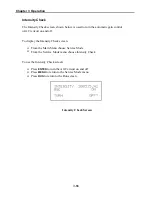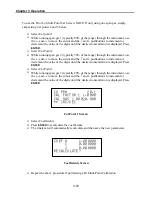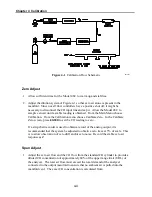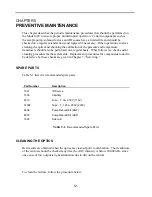
4-1
CHAPTER 4
CALIBRATION
This chapter describes the procedures for performing a standard zero/span calibration and
Multi-Point calibrations of the Model 48C. The information described here is more than
adequate to perform the calibration. However, if greater detail is needed, please refer to
the Quality Assurance Handbook for Air Pollution Measurement Systems
1
.
EQUIPMENT REQUIRED
CO Concentration Standard
A Cylinder of CO in air containing an appropriate concentration of CO suitable for the
selected operating range of the analyzer under calibration is necessary. The assay of the
cylinder must be traceable either to a National Institute of Standards and Technology
(NIST) CO in Air Standard Reference Material (SRM) or an NIST/EPA approved gas
manufacturer's Certified Reference Material (CRM). A recommended protocol for
certifying CO gas cylinders against a CO, SRM or CRM is given in the Quality
Assurance Handbook
1
. The CO gas cylinder should be recertified on a regular basis
determined by the local quality control program.
Zero Air Generator
Zero air, free of contaminants which will cause a detectable response on the CO analyzer
is required. The zero air should contain <0.01 ppm CO. Since the Model 48C is virtually
interference free, it is only necessary to ensure that CO has been removed. It should be
noted that zero air as supplied in cylinders from commercial suppliers typically contain
CO concentrations in the 0.1 - 0.3 ppm range. Thus cylinder zero air should be scrubbed
of the residual CO prior to its use in the Model 48C as a dilution gas or a zero standard.
Room air which has been scrubbed of CO can be used as the zero air source. It is not
necessary to remove SO
2
, NO, NO
2
, CO
2
, water vapor, or hydrocarbons, since the Model
48C does not respond to these molecules. If water vapor is not removed, it might be
necessary to correct the flow measurement data when calculating the dilution ratio of the
span CO reference (see below).
A platinum on alumina catalyst, operated at 250
o
C, has been found to be a convenient
oxidizer to convert CO to CO
2
.
If a zero air source is required, the following interferant removal methods are
recommended.
Summary of Contents for 48C
Page 4: ......
Page 12: ......
Page 14: ......
Page 18: ......
Page 27: ...Chapter 3 Operation 3 3 Figure 3 2 Flowchart of Menu Driven Software ...
Page 112: ......
Page 116: ......
Page 120: ......
Page 123: ...Chapter 7 Servicing 7 3 Figure 7 2 Model 48C Component Layout 48P737 ...
Page 125: ...Chapter 7 Servicing 7 5 Figure 7 3 Optical Bench Exploded View 42P761 ...
Page 138: ......
Page 146: ...Chapter 9 Optional Equipment 9 2 Figure 9 2 Model 48C Dimensional Outline D42P725 ...
Page 155: ...Chapter 9 Optional Equipment Figure 9 8 Purge Housing Assembly 9 11 ...
Page 158: ......
Page 178: ...Appendix B RS 232 Commands B 20 µ ...
Page 184: ......
Page 186: ...C 2 ...
Page 187: ...C 3 ...
Page 188: ...C 4 ...
Page 189: ...C 5 ...
Page 190: ...C 6 ...
Page 191: ...C 7 ...
Page 192: ...C 8 ...
Page 193: ...C 9 ...
Page 194: ...C 10 ...
Page 195: ...C 11 ...
Page 196: ...C 12 ...
Page 197: ...C 13 ...
Page 198: ...C 14 ...
Page 199: ...C 15 ...
Page 200: ......
Page 201: ...APPENDIX D PUMP MAINTENANCE ...
Page 202: ......
Page 203: ......
Page 204: ......
















































